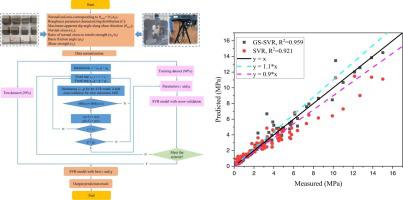Materials Today Communications ( IF 3.7 ) Pub Date : 2023-07-31 , DOI: 10.1016/j.mtcomm.2023.106780 Shijie Xie , Hang Lin , Yifan Chen , Hongyu Duan , Hongwei Liu , Baohua Liu

|
The shear strength of rock fractures serves as a crucial control on the strength and deformation behaviour of engineering rock masses. To reduce the uncertainties in the shear strength evaluation, a hybrid machine learning model (GS-SVR model) of the support vector regression (SVR) underpinned by the grid search optimization algorithm (GS) was proposed. It achieves the prediction of shear strength by generalisation and deduction of a large amount of data on rock fracture parameters, which avoids the complex derivation of theoretical equations. For practical application, a dataset comprising more than 134 shear tests on various rocks was compiled to collect the relevant three-dimensional morphological and mechanical parameters for training and prediction. Three classical shear strength models and the original SVR model were introduced for further comparison. Finally, sensitivity analysis was carried out to explore the relative importance of input variables to the shear strength. The results showed that the GS- SVR model (correlation coefficient R2= 0.984, root mean squared error RMSE=0.383) outperformed the original SVR model (R2= 0.936, RMSE=0.568). Moreover, compared with three classical shear strength models, the prediction results of the GS-SVR model were also most consistent with the experimental results (with the lowest RMSE and the highest R2). This machine learning model enhanced by GS can be used as a reliable and accurate shear strength prediction tool to partially replace laboratory tests to save costs.
Data Avail ability Statement
Some or all data or models that support the findings of this study are available from the corresponding author upon reasonable request.
中文翻译:

使用支持向量回归和网格搜索优化预测岩石裂缝的抗剪强度
岩石裂隙的抗剪强度对工程岩体的强度和变形行为起着至关重要的控制作用。为了减少抗剪强度评估中的不确定性,提出了一种以网格搜索优化算法(GS)为基础的支持向量回归(SVR)的混合机器学习模型(GS-SVR模型)。它通过大量岩石破裂参数数据的归纳和推导,实现抗剪强度的预测,避免了复杂的理论方程推导。为了实际应用,我们编制了包含对各种岩石进行超过 134 次剪切测试的数据集,以收集相关的三维形态和力学参数用于训练和预测。介绍了三种经典的抗剪强度模型和原始SVR模型进行进一步比较。最后,进行敏感性分析,探讨输入变量对剪切强度的相对重要性。结果表明,GS-SVR模型(相关系数R2 = 0.984,均方根误差 RMSE=0.383)优于原始 SVR 模型(R 2 = 0.936,RMSE=0.568)。而且,与三种经典的剪切强度模型相比,GS-SVR模型的预测结果也与实验结果最为一致(RMSE最低,R 2 最高)。这种由 GS 增强的机器学习模型可以作为可靠且准确的剪切强度预测工具,部分替代实验室测试以节省成本。
数据可用性声明
支持本研究结果的部分或全部数据或模型可根据合理要求从通讯作者处获得。

































 京公网安备 11010802027423号
京公网安备 11010802027423号